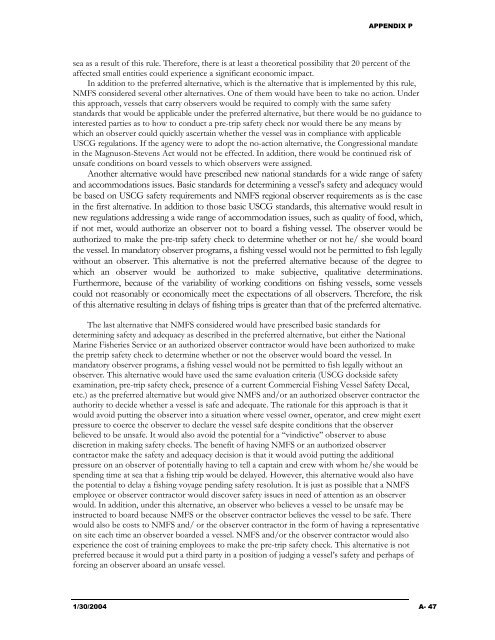West Coast Groundfish Observer Program Manual, Part2 - NOAA
West Coast Groundfish Observer Program Manual, Part2 - NOAA
West Coast Groundfish Observer Program Manual, Part2 - NOAA
Create successful ePaper yourself
Turn your PDF publications into a flip-book with our unique Google optimized e-Paper software.
APPENDIX P<br />
sea as a result of this rule. Therefore, there is at least a theoretical possibility that 20 percent of the<br />
affected small entities could experience a significant economic impact.<br />
In addition to the preferred alternative, which is the alternative that is implemented by this rule,<br />
NMFS considered several other alternatives. One of them would have been to take no action. Under<br />
this approach, vessels that carry observers would be required to comply with the same safety<br />
standards that would be applicable under the preferred alternative, but there would be no guidance to<br />
interested parties as to how to conduct a pre-trip safety check nor would there be any means by<br />
which an observer could quickly ascertain whether the vessel was in compliance with applicable<br />
USCG regulations. If the agency were to adopt the no-action alternative, the Congressional mandate<br />
in the Magnuson-Stevens Act would not be effected. In addition, there would be continued risk of<br />
unsafe conditions on board vessels to which observers were assigned.<br />
Another alternative would have prescribed new national standards for a wide range of safety<br />
and accommodations issues. Basic standards for determining a vessel’s safety and adequacy would<br />
be based on USCG safety requirements and NMFS regional observer requirements as is the case<br />
in the first alternative. In addition to those basic USCG standards, this alternative would result in<br />
new regulations addressing a wide range of accommodation issues, such as quality of food, which,<br />
if not met, would authorize an observer not to board a fishing vessel. The observer would be<br />
authorized to make the pre-trip safety check to determine whether or not he/ she would board<br />
the vessel. In mandatory observer programs, a fishing vessel would not be permitted to fish legally<br />
without an observer. This alternative is not the preferred alternative because of the degree to<br />
which an observer would be authorized to make subjective, qualitative determinations.<br />
Furthermore, because of the variability of working conditions on fishing vessels, some vessels<br />
could not reasonably or economically meet the expectations of all observers. Therefore, the risk<br />
of this alternative resulting in delays of fishing trips is greater than that of the preferred alternative.<br />
The last alternative that NMFS considered would have prescribed basic standards for<br />
determining safety and adequacy as described in the preferred alternative, but either the National<br />
Marine Fisheries Service or an authorized observer contractor would have been authorized to make<br />
the pretrip safety check to determine whether or not the observer would board the vessel. In<br />
mandatory observer programs, a fishing vessel would not be permitted to fish legally without an<br />
observer. This alternative would have used the same evaluation criteria (USCG dockside safety<br />
examination, pre-trip safety check, presence of a current Commercial Fishing Vessel Safety Decal,<br />
etc.) as the preferred alternative but would give NMFS and/or an authorized observer contractor the<br />
authority to decide whether a vessel is safe and adequate. The rationale for this approach is that it<br />
would avoid putting the observer into a situation where vessel owner, operator, and crew might exert<br />
pressure to coerce the observer to declare the vessel safe despite conditions that the observer<br />
believed to be unsafe. It would also avoid the potential for a ‘‘vindictive’’ observer to abuse<br />
discretion in making safety checks. The benefit of having NMFS or an authorized observer<br />
contractor make the safety and adequacy decision is that it would avoid putting the additional<br />
pressure on an observer of potentially having to tell a captain and crew with whom he/she would be<br />
spending time at sea that a fishing trip would be delayed. However, this alternative would also have<br />
the potential to delay a fishing voyage pending safety resolution. It is just as possible that a NMFS<br />
employee or observer contractor would discover safety issues in need of attention as an observer<br />
would. In addition, under this alternative, an observer who believes a vessel to be unsafe may be<br />
instructed to board because NMFS or the observer contractor believes the vessel to be safe. There<br />
would also be costs to NMFS and/ or the observer contractor in the form of having a representative<br />
on site each time an observer boarded a vessel. NMFS and/or the observer contractor would also<br />
experience the cost of training employees to make the pre-trip safety check. This alternative is not<br />
preferred because it would put a third party in a position of judging a vessel’s safety and perhaps of<br />
forcing an observer aboard an unsafe vessel.<br />
1/30/2004 A- 47
















